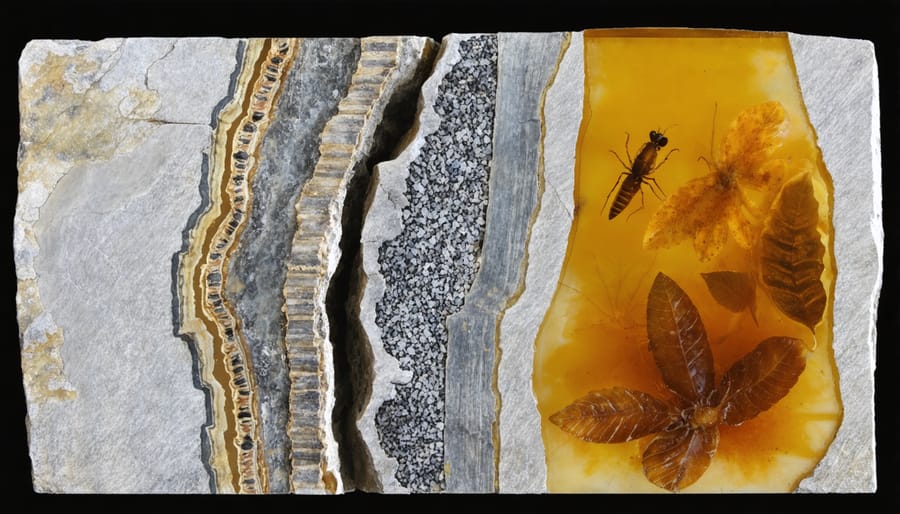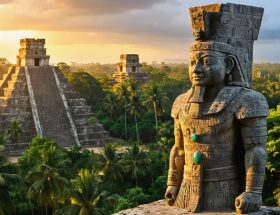Fossils tell Earth’s most fascinating stories, preserving ancient life forms through remarkable natural processes that transform organic remains into enduring stone records. These prehistoric treasures survive through five distinct preservation types: permineralization, carbonization, replacement, molds and casts, and unaltered preservation. Each method creates unique fossil specimens that offer scientists invaluable insights into extinct species, ancient ecosystems, and Earth’s evolutionary history. Understanding these preservation mechanisms not only illuminates how fossils form but also guides modern conservation efforts to protect these irreplaceable windows into our planet’s past. From the delicate preservation of insects in amber to the complete mineralization of dinosaur bones, each type reveals different aspects of prehistoric life, making fossil preservation one of paleontology’s most crucial areas of study.
This introduction combines scientific authority with accessible language, immediately engaging readers while establishing the foundational concepts needed to explore fossil preservation types in detail. It bridges the gap between technical understanding and practical application, setting the stage for a deeper discussion of each preservation method and its significance in both natural history and modern conservation practices.
The Basic Process of Fossilization in Stone
Mineralization and Replacement
One of the most common fossil preservation methods occurs through mineral replacement in rocks, where original organic materials are gradually replaced by minerals. This process begins shortly after burial when groundwater carrying dissolved minerals seeps through the sediment surrounding the organism. As the organic matter decomposes, minerals precipitate and fill the spaces, creating a stone replica of the original specimen.
Common replacement minerals include calcite, silica, and pyrite, each creating fossils with distinct characteristics. Silica replacement often results in exquisitely detailed preservation, while pyrite creates striking metallic fossils. The process can preserve both hard parts, like shells and bones, and occasionally soft tissues, though the latter is rare.
The speed and quality of mineralization depend on several factors, including the surrounding sediment type, groundwater chemistry, and the original composition of the organism. In ideal conditions, mineralization can preserve microscopic details of the original structure, providing scientists with valuable information about ancient life forms.
Environmental Conditions
The preservation of fossils requires specific environmental conditions that work together during the sedimentary rock formation process. The most crucial factor is rapid burial, which protects organic remains from decomposition and scavenging. This typically occurs in environments with consistent sediment deposition, such as river deltas, lakebeds, or marine environments.
Temperature and pressure play vital roles in fossil formation. Moderate temperatures help prevent complete decomposition while allowing mineral replacement to occur. However, excessive heat or pressure can destroy organic materials or alter them beyond recognition. The chemical composition of surrounding sediments and groundwater is equally important, as it determines the type of mineralization that will occur.
Oxygen-poor environments are particularly conducive to fossil preservation, as they slow down bacterial decomposition. Areas with fine-grained sediments, like mud or silt, often provide better preservation conditions than coarse materials. These environments create natural seals that protect organic materials from destructive elements while allowing the gradual process of mineralization to take place.
Common Types of Fossil Preservation
Permineralization
Permineralization stands as one of the most common and well-preserved types of fossilization, where minerals gradually replace organic materials within cellular spaces. This process begins when groundwater rich in dissolved minerals, typically silica or calcium carbonate, seeps into the porous spaces of organic remains. The most famous example of this process can be seen in petrified wood formation, where the original wood structure is perfectly preserved down to the cellular level.
During permineralization, minerals crystallize within the cellular chambers and microscopic spaces of the organism, creating a detailed replica of the original tissue structure. This process is particularly effective in preserving hard tissues like bones, shells, and wood, as their natural porosity allows for better mineral infiltration. The resulting fossils maintain exceptional detail, often preserving intricate features such as growth rings in wood or bone cell structures.
Common mineralizing agents include silica, calcite, and pyrite, each creating distinct types of preservation. Silica-based permineralization typically produces the most durable fossils, while calcite-based specimens may be more susceptible to weathering over time. The quality of preservation depends largely on how quickly the mineralization process begins after death and the environmental conditions during fossilization.
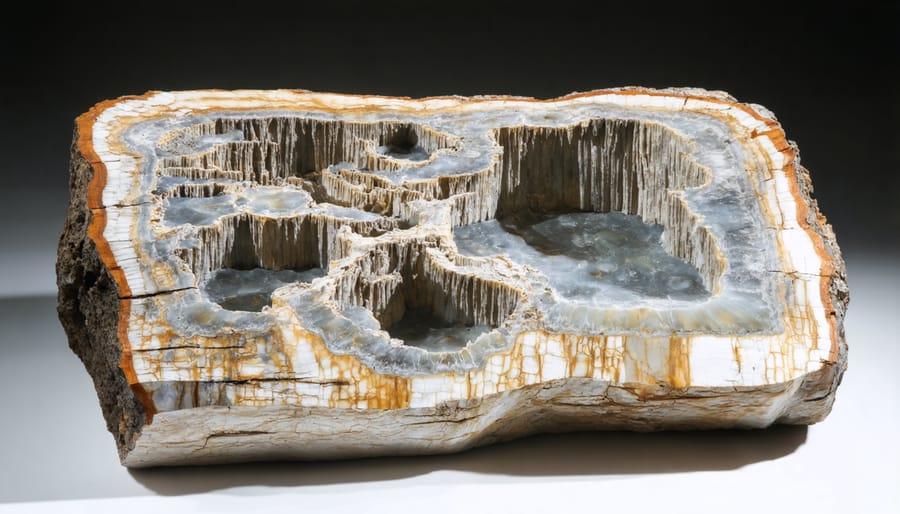
Carbonization
Carbonization represents one of the most common and distinctive fossil preservation processes, where the organic material of an organism is gradually replaced by carbon, leaving behind a dark, film-like impression. This process typically occurs when plant or animal remains are buried in oxygen-poor environments with fine-grained sediments.
During carbonization, the soft tissues decompose, but rather than disappearing completely, they leave behind a thin layer of carbon residue that outlines the original organism’s shape. This carbon film preserves remarkable detail, particularly in plant fossils, where leaf veins, stems, and even cellular structures can remain visible millions of years later.
The process begins when organic matter is quickly buried, preventing complete decomposition. Over time, heat and pressure force out other elements like hydrogen, oxygen, and nitrogen, leaving behind a concentrated carbon residue. This creates the characteristic black or dark brown coloration seen in many fossil specimens.
Carbonized fossils are particularly valuable to paleontologists because they often preserve delicate features that might otherwise be lost in other preservation types. Common examples include ferns, leaves, insects, and fish, which are frequently found in shale deposits. These fossils provide crucial information about ancient ecosystems and the evolution of various species through time.
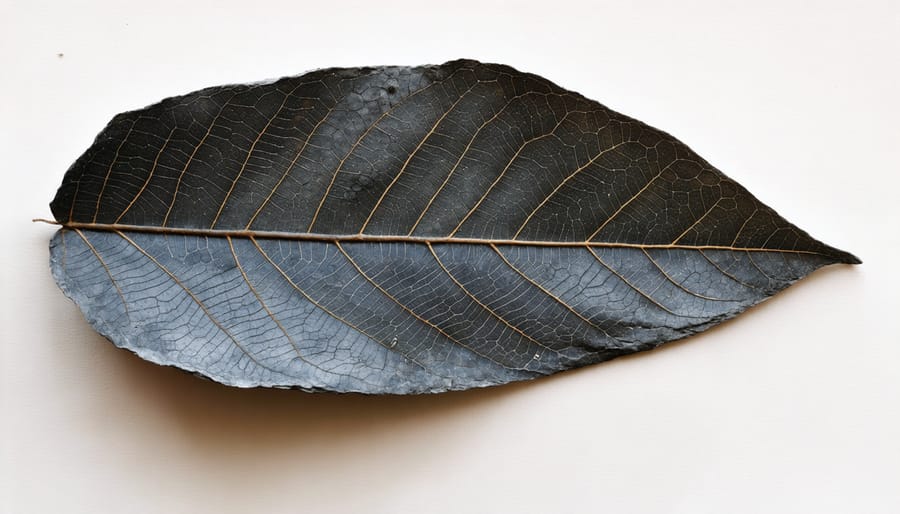
Molds and Casts
Molds and casts represent one of the most common types of fossil preservation, where the original organism’s shape is preserved in rock through a two-step process. When an organism dies and is buried in sediment, its soft tissues decompose, leaving a hollow impression in the surrounding material. This negative impression is called a mold, which precisely captures the external features of the organism.
Natural molds form when sediment hardens around the organism before it completely decomposes. As the organic matter disappears, it leaves behind a cavity that perfectly mirrors the creature’s original shape. These molds can preserve remarkable detail, from the texture of shells to the delicate patterns of leaves.
Casts form when these mold cavities later fill with minerals carried by groundwater, creating a solid replica of the original organism. Common filling materials include calcite, silica, and iron minerals. The resulting cast maintains the external shape of the organism but typically doesn’t preserve internal structures unless the original organism was hollow.
Some fossils can form both external and internal molds. External molds show the organism’s outer surface, while internal molds reveal the shape of internal cavities. This dual preservation is particularly common in shellfish fossils, where both the inner and outer surfaces of the shell create distinct impressions in the surrounding sediment.
Amber Preservation
Amber preservation represents one of nature’s most remarkable methods of fossilization, where ancient organisms become trapped and preserved in tree resin that eventually hardens into amber. This process creates exceptionally detailed fossils, often preserving delicate structures that would typically decompose in other conditions.
The preservation process begins when tree resin flows over an organism, completely encasing it. The sticky substance prevents decay by sealing out oxygen and water while also containing natural compounds that act as antibacterial agents. Over millions of years, the resin undergoes chemical changes through a process called polymerization, transforming into the hardened amber we find today.
What makes amber fossils particularly valuable to scientists is their ability to preserve soft tissues, colors, and even microscopic details of ancient life forms. Small insects, plant materials, and occasionally larger organisms can be found in pristine condition, appearing almost as they did millions of years ago. Some specimens even contain preserved DNA fragments, though not enough for cloning as popularized in fiction.
Famous amber deposits can be found in the Baltic region, Dominican Republic, and Myanmar, with specimens dating back to the Cretaceous period. These fossils provide invaluable insights into ancient ecosystems and the evolution of various species, particularly insects and small organisms that rarely preserve well through other fossilization methods.
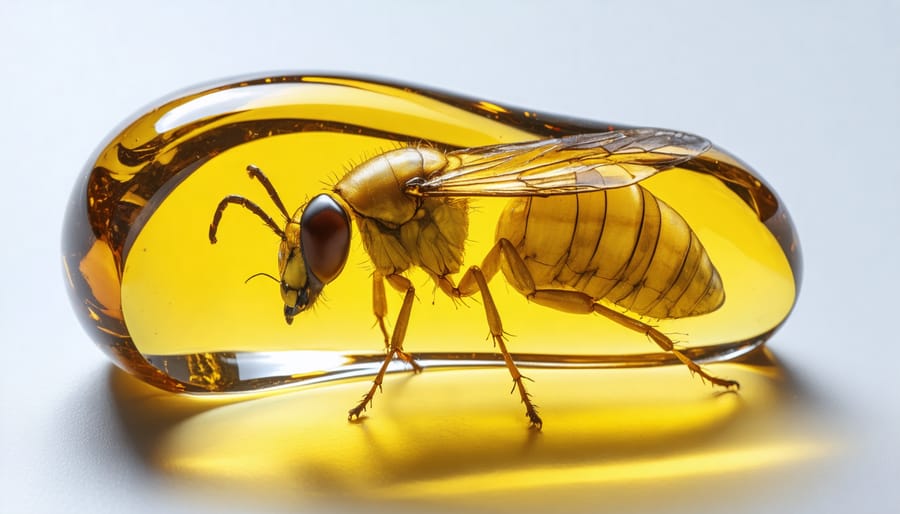
Conservation Challenges and Solutions
Environmental Threats
Fossil-bearing stones face numerous environmental threats that can compromise their integrity and scientific value. Weather exposure presents one of the most significant challenges, as repeated cycles of freezing and thawing can cause stone to crack and split, potentially destroying fossil specimens within. Rainwater is particularly destructive, as it can dissolve certain mineral components and create acidic conditions that deteriorate fossils over time.
Temperature fluctuations pose another serious concern, causing thermal stress that can lead to microscopic fissures in the stone. These small cracks often expand over time, allowing moisture to penetrate deeper into the material and accelerating deterioration. In coastal areas, salt crystallization poses an additional risk, as salt-laden moisture can seep into stone pores and create destructive crystalline formations.
Human activity also threatens fossil preservation. Construction projects, mining operations, and improper excavation techniques can damage or completely destroy fossil-bearing formations. Even well-intentioned amateur fossil hunting can inadvertently harm specimens if proper extraction methods aren’t followed.
Air pollution, particularly in urban environments, creates additional preservation challenges. Sulfur dioxide and nitrogen oxides in polluted air combine with moisture to form acid rain, which can gradually erode both the stone matrix and the fossils themselves. Carbon dioxide emissions contribute to increased atmospheric acidity, further accelerating the natural weathering process.
To protect fossil-bearing stones, proper storage conditions and handling procedures are essential. Climate-controlled environments, appropriate protective coatings, and regular monitoring help minimize these environmental threats and ensure the long-term preservation of these valuable scientific specimens.
Preservation Techniques
Modern preservation techniques for fossil-bearing stones combine traditional stone conservation methods with specialized approaches designed to protect both the stone matrix and the embedded fossils. Conservators typically begin with thorough documentation, including detailed photography and 3D scanning, to record the fossil’s condition before treatment.
Surface cleaning is performed using gentle methods such as soft brushes and controlled air pressure to remove loose debris without damaging delicate fossil structures. For more stubborn deposits, specialists may employ micro-abrasive cleaning systems with precisely controlled pressure and particle size.
Consolidation plays a crucial role in preservation, particularly for fragile specimens. Conservators apply specially formulated consolidants that penetrate the stone and strengthen both the fossil material and surrounding matrix. These products are carefully selected to ensure long-term stability and reversibility if future treatment becomes necessary.
Environmental control is essential for preserved specimens. Storage and display areas must maintain stable temperature and humidity levels to prevent deterioration. UV-filtered lighting systems protect against light damage, while custom-designed mounts provide proper support to prevent stress on vulnerable areas.
Preventive measures include regular monitoring for signs of deterioration, such as cracking or mineral efflorescence. Digital mapping helps track changes over time, allowing conservators to address potential issues before they become serious problems. When transportation is necessary, specially designed cushioned containers protect specimens from vibration and impact damage.
For particularly significant specimens, conservators may create high-quality replicas using modern scanning and 3D printing technology, allowing the original to remain safely preserved while copies serve educational and display purposes.
Understanding the various types of fossil preservation is crucial for anyone involved in natural stone applications, from archaeologists to architectural designers. These preservation methods not only tell us fascinating stories about Earth’s ancient past but also inform how we handle and display fossilized specimens in modern contexts.
The five main types of preservation – permineralization, carbonization, molds and casts, replacement, and amber preservation – each offer unique insights into prehistoric life and present distinct challenges for conservation. By understanding these processes, professionals can better assess the stability of fossilized materials in building applications and make informed decisions about their use and display.
The preservation type directly impacts a fossil’s durability and aesthetic value in architectural applications. For instance, permineralized fossils often provide the most stable and visually striking specimens for decorative stone installations, while carbonized fossils require more careful handling and environmental control.
For those working with natural stone, this knowledge is invaluable for proper material selection and maintenance. It helps ensure that fossil-bearing stones are appropriately preserved for future generations while maintaining their aesthetic appeal in contemporary designs. Whether you’re selecting stone slabs for a museum display or incorporating fossil-rich limestone into a building facade, understanding these preservation mechanisms is essential for successful project outcomes.

